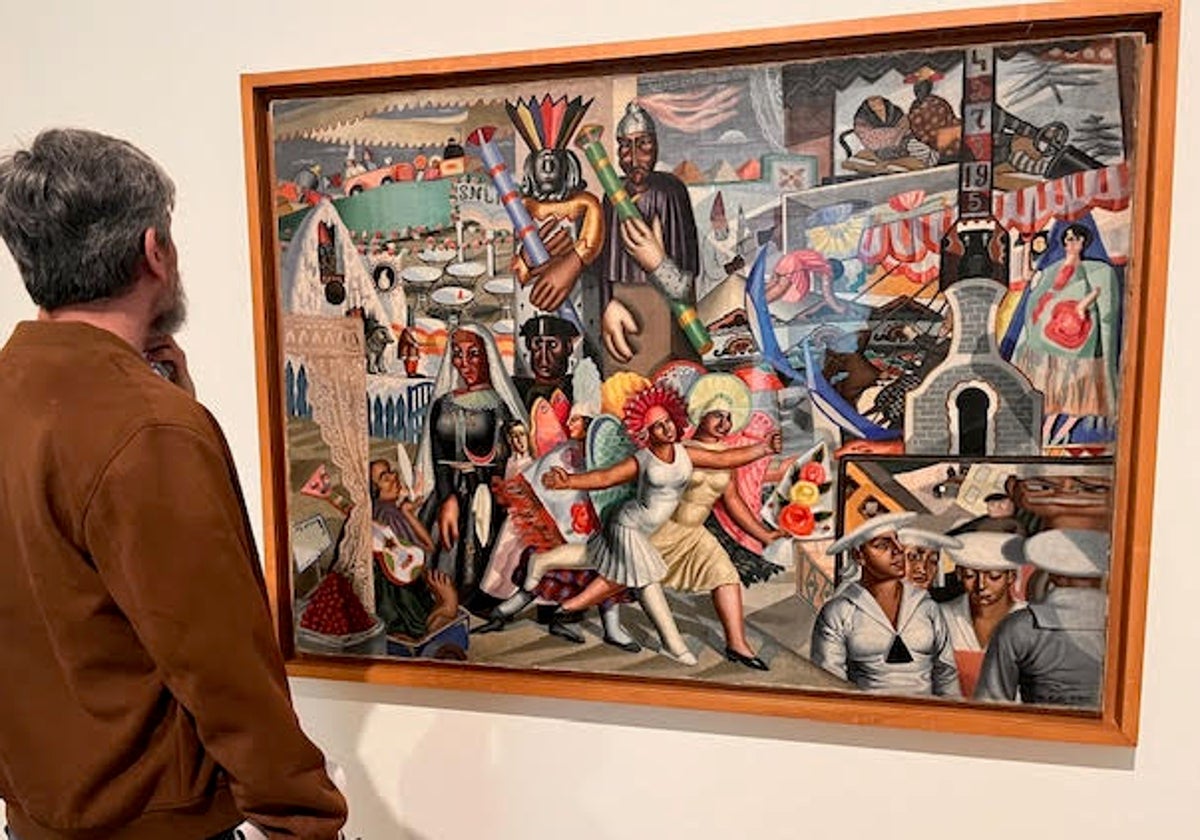The Rebellious and Transgressive Genius of Maruja Mallo Captivates at the Centro Botín
Featuring over a hundred works by the painter who shook the Generation of '27 / The 'necessary' exhibition is the most significant of the multifaceted Galician artist, showcasing her journey from post-impressionism and surrealism to 'fantascience'.
Miguel Lorenci
Santander
Friday, 11 April 2025, 13:50
"She is the one who knows the value of the heterogeneous and is another sprout of the great genius of Spain, which is a genius of heterogeneity." This is how Ramón Gómez de la Serna referred to Maruja Mallo (Viveiro 1902– Madrid, 1995), a rebellious and transgressive artist. A vital agitator who shook and coloured the Generation of '27, enriching it and yet being sidelined by it. As a leading figure of the 'sinsombrero' battlers, Mallo took the world and genius by storm, championing with her palette and brushes a group that anticipated feminism in a misogynistic, clerical Spain that wanted women at home and subservient to men, against which she rebelled through painting.
The Centro Botín opens its season by reviving her earthy talent with the exhibition 'Maruja Mallo: Mask and Compass. Paintings and Drawings from 1924 to 1982', the most comprehensive retrospective of the "fascinating" and iconoclastic Galician artist who, according to Dalí, was "half angel, half seafood". Transgressive in all areas, Ortega y Gasset invited her to exhibit solo in 1928 with her legendary 'Verbenas' series. Influenced by surrealism, she interacted with Magritte, Picasso, Ernst, Miró, and De Chirico. A staunch Republican, she went into exile in Argentina and the USA, returning in 1962, never as recognised as her work, which is now celebrated and reclaimed with a historic and exceptional exhibition running until 14 September.
Co-produced by the Museo Nacional Reina Sofía and curated by Patricia Molins, it gathers over a hundred pieces, including 84 paintings and drawings from Mallo's long and challenging career. Six decades in which she painted barely 150 canvases, journeying from the magical realism and popular themes of her early years to the geometric and fantastic configurations of her later works.

"We had a debt with Maruja Mallo, and it is settled with this exhibition, which gathers three-quarters of her production," celebrated Manuel Segade, director of the Reina Sofía, a museum that will host the expanded historic exhibition in October. "Mallo is not a rarity of her time; she is the greatest contribution to the imagination of '27," summarised Segade. "It is outrageous that such an exhibition had not been done before. Mallo was not a crazy woman who painted herself like a door; she herself was a work of art that fascinated in the twenties and fascinates now," emphasised the curator.

The exhibition repositions and reclaims one of the most unique and prominent figures of the universal group, including Federico García Lorca, Luis Buñuel, and Salvador Dalí. The group of committed and militant poets like Rafael Alberti, who, however, relegated colleagues like Teresa León, María Zambrano, Rosa Chacel, Concha Méndez, or Ernestina de Champourcín, recently rescued from the folds of a history written by men and decidedly anti-feminine.
With her "singular and heterogeneous" production, Maruja Mallo - Ana María Gómez González on her ID - "blurred the boundaries between the popular and the avant-garde, between aesthetics and politics," asserts the curator. She is defined as "a visionary artist of insatiable curiosity who managed to reflect the concerns of her time and anticipate many of those that trouble us today, imagining a fairer, more inclusive, and sustainable world and responding to all challenges."
From Geography to Cosmography
Following a chronological order, the exhibition begins with Mallo's time at the Academy of San Fernando, where she studied with professors like Chicharro and Romero de Torres, whose post-impressionist influence is present in her early paintings. It concludes with her work of a fantastic, scientific, and futuristic tone. "Seeking to reconcile reason with magic, she had reached science fiction, the form that the marvellous took in the 20th century," notes the curator.

Her work is organised in series, something she maintained throughout most of her life and which the exhibition adopts. "Mallo's scenarios shift from the popular neighbourhoods of Madrid to the outskirts, ending in the cosmos, the non-place par excellence, delving into the chain that links humans with the most distant, the cell or the universe in its journey from geography to cosmography," summarises Molins.
Women, Protagonists
Mallo began painting in the ruined and highly polarised Spain before the Civil War, when artists and intellectuals showed a strong social and aesthetic commitment to regenerate the country and lift art from the post-avant-garde confusion. The creators whom the Republic prevented from voting had to build their image as modern, active, and professional artists and women. Mallo made them protagonists of her paintings, "creating an unprecedented female worldview," according to Molins. "She creates in her work a female epic non-existent in previous eras, where the female imagination had been constructed by men, and anticipates that of the feminist artists of the seventies," she adds.
The interest in the popular evolved towards the rural, the land, and the work of the people, incorporating syncretic religiosity, the mix of races, and the lush landscapes in the paintings of her American exile after the start of the Civil War. In that journey, "she created some of the most unclassifiable and fascinating images of the 20th century, and of absolute relevance today, anticipating racial, gender, ecological, and identity conflicts that concern us today," assures Molins.
For the first time, the five scenes of the 'Las Verbenas' series (1927-1928) will be gathered since they were exhibited in the Revista de Occidente at the behest of Ortega y Gasset. 'El Mago/Pim Pam Pum' (1926), loaned from the Art Institute of Chicago, will take a few weeks to arrive in Santander, but 'Kermesse' (1928) from the Pompidou in Paris is already here. Three from the Reina Sofía and the two remaining from private collections. Opposite them is another crucial series 'Cloacas y Campanarios' (1930-32).

The exhibition includes documents, photos, and writings by the artist herself preserved in the Lafuente Archive and other collections, showcasing her creative process and the initial dissemination her work found among her contemporaries.
In addition to the Reina Sofía and the Art Institute of Chicago, works have been loaned by the Centre Georges Pompidou in Paris; the Museo Nacional de Artes Visuales in Montevideo; the Benito Quinquela Martín and the Museo de Arte Latinoamericano, both in Buenos Aires; the Provincial de Bellas Artes Rosa Galisteo in Santa Fe (Argentina); the Patio Herreriano in Valladolid, the Provincial de Lugo, and important national and international private collections.
The catalogue includes a biography of Mallo written by Juan Pérez de Ayala, one of the earliest scholars of her work, texts by the curator, Argentine researcher Alejandra Zanetta, American artist and writer Johanna Hedva, and writings by Maruja Mallo herself, some of them unpublished.

The 'Sinsombrero' Agitator Who Took the World by Storm
A century ago, not wearing a hat was a sign of rebellion. A handful of women, mostly intellectuals and artists, clung to it to symbolise their desire for freedom and independence. Led by Maruja Mallo, they were soon dubbed 'Las Sinsombrero'. A heterogeneous group whose battered memory has been rescued in recent years.
And indeed, the official history of the Silver Age of our culture marginalised the talented women who contributed decisively to its brilliance in an unrecognised Golden Age for women. Their forgotten rebellion had its symbol in a gesture as trivial as it was revolutionary: their refusal to wear a hat, the obligatory accessory for ladies and damsels of the twenties and thirties of the 20th century. The gesture was made by the mischievous and unruly Maruja Mallo, who, along with Margarita Manso and her friends Lorca and Dalí, liberated herself with noise and pomp from the garment that "congested" her ideas in what we would today call a performance.
"They stoned us and called us 'maricones' for not wearing a hat," recalled the Galician painter of that "rebellious and narcissistic" act staged in the middle of Puerta del Sol in the mid-twenties. It was a first step to make visible "free and transgressive, passionate and fascinating" women constrained in a Spain where "biological essentialism" decreed the inequality between sexes and affirmed the null intellectual capacity of the weak female gender "scientifically," as highlighted by Tania Balló (Barcelona, 1977), author of 'Las Sinsombrero' (Espasa), an essay that vindicates the memory and vicissitudes of a brilliant female generation that rebelled against the social, ideological, and cultural corsets embedded in the genome of a relentlessly macho Spain that a century ago condemned them to be mothers and wives.



